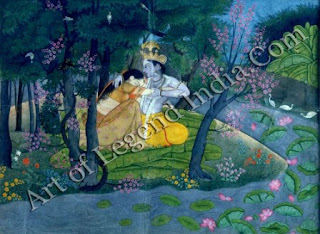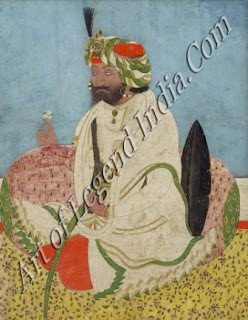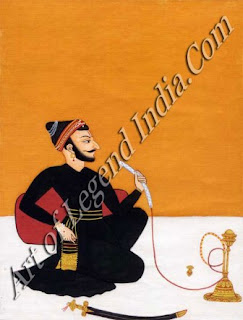Unlike the widely scattered
courts of Rajasthan, the numerous minor Rajput kingdoms of the Himalayan
foothills were clustered in an area only three hundred miles long by a hundred
wide. Although they shared a similar cultural background to the southern Rajput
courts, they were effectively separated from them by the broad expanse of the
Punjab plains, and they were also less affected by Mughal incursions. This
comparative isolation, together with the closer communications between the Hill
courts, contributed to the development of some of the most expressive styles of
Indian painting, characterised in their earlier phases by a controlled
vehemence of colour and line, and later by a mellifluous idiom that combined
Mughal technique with Rajput devotional and romantic sensibility.
The origins of the first
classic style of Pahari (Hill) painting, associated with the court of Basohli,
are still not understood, though it may have had antecedents in the widespread
pre-Mughal style as well as in local Hill idioms. An early illustration to the
Rasamanjari, a poetical text classifying lovers and their behaviour, reveals a
fully formed and highly charged style, with a taut line and vibrant palette.
The interpretation of literary conceits is as direct as in Rajasthani
manuscripts.
 A lady who has been secretly unfaithful explains to her confidante
that the love-marks on her breast were in fact scratches caused by the
household cat as it chased a rat during the night. The cat and the rat appear
on the pavilion roofer here is nothing here of the hybrid weakness sometimes
found in Rajasthani work affected by Popular Mughal fluence. So confident was
the Pahari artists' vision that Mugha portraiture could be reinterpreted with
equal intensity. The Mankot raja with a rosary, huqqa and sword is not a
psychological study of an individual but a celebration of the proud Rajput type
silhouetted against a hot yellow background, orange bolster and white
floorsprcad. Painting at the court of Kulu had a particular wildness and zest, Kuutala
raga, from an extended ragamala series of the Pahari type, is depicted as a
prince feeding pigeons; Akbar himself had been fond of the sport of
pigeon-flying, which was known as ishq-bazi or love-play'.
A lady who has been secretly unfaithful explains to her confidante
that the love-marks on her breast were in fact scratches caused by the
household cat as it chased a rat during the night. The cat and the rat appear
on the pavilion roofer here is nothing here of the hybrid weakness sometimes
found in Rajasthani work affected by Popular Mughal fluence. So confident was
the Pahari artists' vision that Mugha portraiture could be reinterpreted with
equal intensity. The Mankot raja with a rosary, huqqa and sword is not a
psychological study of an individual but a celebration of the proud Rajput type
silhouetted against a hot yellow background, orange bolster and white
floorsprcad. Painting at the court of Kulu had a particular wildness and zest, Kuutala
raga, from an extended ragamala series of the Pahari type, is depicted as a
prince feeding pigeons; Akbar himself had been fond of the sport of
pigeon-flying, which was known as ishq-bazi or love-play'.
Although there is some evidence
of strongly Mughal-influenced work in the Hills in the late 17th century,
comparable to that of the Bikaner school, this was exceptional during the first
phase of Pahari painting. But in the second quarter of the 18th century
a fundamental change of direction took place. Artists trained in the Mughal
style began to arrive in increasing numbers, particularly after the sack of
Delhi in 1739. From being the vehicle of a jaded sensuality, their technique
became revitalised in lyrical depictions of Hindu poetical and devotional
subjects, in a development paralleled in Rajasthan by the less subtle
Kishangarh style.
Members of the family of the
artist Pandit Seu, who were based at Guler but travelled widely among the Hill
courts, were influential in shaping and disseminating the new style. One of
Seu's sons was the great portrait artist Nainsukh, who had probably received
some Mughal training. He enjoyed an unusually intimate and understanding
relationship with his patronkthe minor prince Balwant Singh, whom he portrayed
carrying out all the daily activities of a nobleman: hunting, listening to
music, inspecting a horse, or simply writing a letter or preparing to go to
bed. Compared with the stark Mankot picture, Nainsukh's portraiture and spatial
setting are far more naturalistic. Nevertheless the bold, geometrical
arrangement of the architecture and back-ground areas remains typically Rajput.
A religious subject in the
early Guler style combines the new technical refinement with a devotional feeling
taking the form of tender domestic observation Shiva is shown sewing a garment,
while Parvati strings human heads for his necklace. Their sons, the many-headed
Karttikcya and the elephant-headed Ganesha, who plays with Shiva's cobra, sit
beside them, and their respective vehicles, the bull, lion, peacock and rat,
wait in attendance Wersions of the graceful Guler idiom were developed at
several courts, such as Garhwal to the south-east, where a Barahmasa
illustration of the winter month of Aghan was painted a pair of lovers, idealised
as Radha and Krishna, gaze at one another on a terrace while two cranes fly
skywards.
 The last great Pahari patron
was Raja Sansar Chand of Kangra (1775-1823), whose long reign saw both the
final maturity of Hill painting and the beginning of its decline. Early in his
reign several masterly series of the classic texts celebrating the life of
Krishna were illustrated for him. The love of Radha and Krishna was depicted
with tender directness in idyllic landscape setting. As in earlier periods of
Indian painting, the luxuriant burgeoning of nature serves to enhance and
express the emotions of the human figures. (Krishna is as usual shown as an
elegant, princely figure; perhaps akin to the young Sansar Chand. As at Guler, scenes
of zenana life were also charmingly rendered, with increasingly curvilinear
rhythms, as in a scene of ladies throwing powder and squirting water at the
spring festival of Holi. But, as at Kishangarh, such a sweetly refined style
could only remain fresh for a short time.
The last great Pahari patron
was Raja Sansar Chand of Kangra (1775-1823), whose long reign saw both the
final maturity of Hill painting and the beginning of its decline. Early in his
reign several masterly series of the classic texts celebrating the life of
Krishna were illustrated for him. The love of Radha and Krishna was depicted
with tender directness in idyllic landscape setting. As in earlier periods of
Indian painting, the luxuriant burgeoning of nature serves to enhance and
express the emotions of the human figures. (Krishna is as usual shown as an
elegant, princely figure; perhaps akin to the young Sansar Chand. As at Guler, scenes
of zenana life were also charmingly rendered, with increasingly curvilinear
rhythms, as in a scene of ladies throwing powder and squirting water at the
spring festival of Holi. But, as at Kishangarh, such a sweetly refined style
could only remain fresh for a short time.
 From the beginning of the 19th
century it became facile and sentimental. At the same time, Sansar Chand's
power was lost first to Gurkha invaders and then to the Sikhs, who had won
control of the Punjab plains and now began to annexe the Hill kingdoms.
However, the British traveller William Moorcroft, who visited Sansar Chand in
1820, reports that, though living in reduced circumstances, he was still 'fond
of drawing' and continued to support several artists as well as a zenana of
three hundred ladies. His daily life was still passed in an orderly round of
prayer, conversation, chess, viewing pictures and performances of music and
dance.
From the beginning of the 19th
century it became facile and sentimental. At the same time, Sansar Chand's
power was lost first to Gurkha invaders and then to the Sikhs, who had won
control of the Punjab plains and now began to annexe the Hill kingdoms.
However, the British traveller William Moorcroft, who visited Sansar Chand in
1820, reports that, though living in reduced circumstances, he was still 'fond
of drawing' and continued to support several artists as well as a zenana of
three hundred ladies. His daily life was still passed in an orderly round of
prayer, conversation, chess, viewing pictures and performances of music and
dance.
The Sikhs continued to hold the
Punjab until their displacement by the British in 1849. They commissioned
portraits of their Gurus and themselves in a weakened Pahari manner, to which
they brought little inspiration as patrons. However one of the most imposing of
all Indian portraits is that of Maharaja Gulab Singh. His large figure which
fills the picture area is shown seated holding the familiar props of a sprig of
flowers and a sword. He wears a dextrously composed turban and coat with
sharply ruffled hem, and his face, no longer in profile, stares obliquely away
from the viewer in baleful self-possession.
Writer
– Andrew T0psfield
 A lady who has been secretly unfaithful explains to her confidante
that the love-marks on her breast were in fact scratches caused by the
household cat as it chased a rat during the night. The cat and the rat appear
on the pavilion roofer here is nothing here of the hybrid weakness sometimes
found in Rajasthani work affected by Popular Mughal fluence. So confident was
the Pahari artists' vision that Mugha portraiture could be reinterpreted with
equal intensity. The Mankot raja with a rosary, huqqa and sword is not a
psychological study of an individual but a celebration of the proud Rajput type
silhouetted against a hot yellow background, orange bolster and white
floorsprcad. Painting at the court of Kulu had a particular wildness and zest, Kuutala
raga, from an extended ragamala series of the Pahari type, is depicted as a
prince feeding pigeons; Akbar himself had been fond of the sport of
pigeon-flying, which was known as ishq-bazi or love-play'.
A lady who has been secretly unfaithful explains to her confidante
that the love-marks on her breast were in fact scratches caused by the
household cat as it chased a rat during the night. The cat and the rat appear
on the pavilion roofer here is nothing here of the hybrid weakness sometimes
found in Rajasthani work affected by Popular Mughal fluence. So confident was
the Pahari artists' vision that Mugha portraiture could be reinterpreted with
equal intensity. The Mankot raja with a rosary, huqqa and sword is not a
psychological study of an individual but a celebration of the proud Rajput type
silhouetted against a hot yellow background, orange bolster and white
floorsprcad. Painting at the court of Kulu had a particular wildness and zest, Kuutala
raga, from an extended ragamala series of the Pahari type, is depicted as a
prince feeding pigeons; Akbar himself had been fond of the sport of
pigeon-flying, which was known as ishq-bazi or love-play'.  The last great Pahari patron
was Raja Sansar Chand of Kangra (1775-1823), whose long reign saw both the
final maturity of Hill painting and the beginning of its decline. Early in his
reign several masterly series of the classic texts celebrating the life of
Krishna were illustrated for him. The love of Radha and Krishna was depicted
with tender directness in idyllic landscape setting. As in earlier periods of
Indian painting, the luxuriant burgeoning of nature serves to enhance and
express the emotions of the human figures. (Krishna is as usual shown as an
elegant, princely figure; perhaps akin to the young Sansar Chand. As at Guler, scenes
of zenana life were also charmingly rendered, with increasingly curvilinear
rhythms, as in a scene of ladies throwing powder and squirting water at the
spring festival of Holi. But, as at Kishangarh, such a sweetly refined style
could only remain fresh for a short time.
The last great Pahari patron
was Raja Sansar Chand of Kangra (1775-1823), whose long reign saw both the
final maturity of Hill painting and the beginning of its decline. Early in his
reign several masterly series of the classic texts celebrating the life of
Krishna were illustrated for him. The love of Radha and Krishna was depicted
with tender directness in idyllic landscape setting. As in earlier periods of
Indian painting, the luxuriant burgeoning of nature serves to enhance and
express the emotions of the human figures. (Krishna is as usual shown as an
elegant, princely figure; perhaps akin to the young Sansar Chand. As at Guler, scenes
of zenana life were also charmingly rendered, with increasingly curvilinear
rhythms, as in a scene of ladies throwing powder and squirting water at the
spring festival of Holi. But, as at Kishangarh, such a sweetly refined style
could only remain fresh for a short time.  From the beginning of the 19th
century it became facile and sentimental. At the same time, Sansar Chand's
power was lost first to Gurkha invaders and then to the Sikhs, who had won
control of the Punjab plains and now began to annexe the Hill kingdoms.
However, the British traveller William Moorcroft, who visited Sansar Chand in
1820, reports that, though living in reduced circumstances, he was still 'fond
of drawing' and continued to support several artists as well as a zenana of
three hundred ladies. His daily life was still passed in an orderly round of
prayer, conversation, chess, viewing pictures and performances of music and
dance.
From the beginning of the 19th
century it became facile and sentimental. At the same time, Sansar Chand's
power was lost first to Gurkha invaders and then to the Sikhs, who had won
control of the Punjab plains and now began to annexe the Hill kingdoms.
However, the British traveller William Moorcroft, who visited Sansar Chand in
1820, reports that, though living in reduced circumstances, he was still 'fond
of drawing' and continued to support several artists as well as a zenana of
three hundred ladies. His daily life was still passed in an orderly round of
prayer, conversation, chess, viewing pictures and performances of music and
dance. 












0 Response to "Rajput Painting in the Punjab Hills"
Post a Comment